I recently wrote for the ABA’s Business Law Today about structured legal fees for lawyers in “Plaintiff Lawyer Tax Benefits Other Lawyers Don’t Get.” For nearly 30 years, plaintiff lawyers have been structuring their contingent legal fees based on the seminal tax case of Childs v. Commissioner.[1] Only contingent fees can be structured, and their basic idea is to convert an anticipated lump sum contingent fee into a stream of payments. Payments over time can flatten the peaks and valleys of a lawyer’s income and reduce the need to borrow to finance cases.
An annuity company or third party doles out the payments, so a legal fee structure is a little like a tax-deferred installment plan. It doesn’t rely on the credit-worthiness of the defendant or the client, and it can grow pre- rather than post-tax. The contingent fee lawyer must document the deferral of the legal fee before settlement (although immediately before the settlement is okay), can structure some or all, and can call for payment over any number of years, or life. Some companies even allow borrowing.
Whether the structure involves annuities or securities, the format and documents are important, but done properly, it has not been controversial with the IRS. The tax case uniformly cited as establishing the bona fides of attorney fee structures is Childs, and over the last several decades the IRS has often cited it favorably. But in December 2022, the IRS released Generic Legal Advice Memorandum AM 2022-007[2] (a “GLAM”).
The GLAM does not address the precise fact pattern in Childs or call for it to be overturned. Indeed, the hypothetical facts the IRS addresses in the GLAM are somewhat narrow. However, it is safest to read the IRS missive as a general attack on structured legal fees and as a roadmap for what the IRS may argue in audits. Even so, the GLAM is not binding on any taxpayer and is not published authority, unlike an IRS Revenue Ruling, a Treasury Regulation, or a tax case like Childs.
The GLAM is lengthy (25 pages single-spaced), and makes four arguments why the hypothetical structured fee the GLAM describes should not work in the IRS’s opinion. The IRS says it would violate the assignment of income doctrine, the economic benefit doctrine, and section 83 of the tax code (an IRS argument the Tax Court and 11th Circuit rejected in Childs), and that it is a deferred compensation plan violating section 409A of the tax code. Section 409A says some compensation deferred under regular tax rules should nevertheless be currently taxed if it fails to comply with certain rules.
This last argument regarding section 409A is the biggest surprise, for the Treasury Regulations under Section 409A say that the entire provision does not apply to independent contractors who have two or more customers or clients, among other requirements that are usually satisfied for structured fees. Since the time the relevant Treasury Regulation was released in 2007, it has been widely understood to exempt structured legal fees, since most lawyers have two or more clients. In any case, it is not yet clear if the IRS will have any success with its new positions on certain structured legal fees.
Much of the IRS’s discussion seems to rely on distinguishing its hypothetical from the facts in Childs’ structured fee. This suggests that the IRS may face bigger challenges if it tries to attack structured fees more universally. In any event, the GLAM indicates that the IRS is less comfortable with structured legal fees (or at least with some of them) than was previously thought.
So should lawyers continue structuring fees given this IRS shot across the bow? Most tax advisers would probably say yes, and that is my personal answer. But the GLAM does suggest that paying attention to the specific details and documents is important. Of course, most people are never audited, and that is true for lawyers and structured fees too.
But the release of the GLAM by the IRS suggests that if you happen to be audited, there may be more pushback than was previously thought, particularly if your fee structure looks like low-hanging fruit to the IRS. On that point, it is worth asking how the IRS will identify fee structures, since they are often not reported on a tax return until the installment payments are reported and taxed. But if a lawyer’s legal fee deferral is audited, the IRS may make these arguments. That does not mean the IRS will win, and the specific facts and documents in question are going to matter.
IRS audits can be resolved at the audit stage, where the best result is the IRS saying there is no change. The GLAM may make that happy result more difficult now, depending on the facts and documents. Many IRS audits are resolved a step beyond audit at IRS Appeals. IRS Appeals is still part of the IRS system, but it is independent and tries, usually successfully, to resolve disputes between auditors and taxpayers, often by settlement.
It is even possible that we will end up with another tax case reprising the issues discussed in Childs, though if that occurs, it will take years. And like any tax case, it will be based on the facts and documents in that particular case. In the meantime, in my view, there is no reason that plaintiff lawyers or the structured settlement industry need to stop structuring legal fees, as long as they dot their i’s and cross their t’s.
In fact, some structured settlement brokers report that they are seeing a decided uptick in legal fee structures. Ironically, perhaps the GLAM has made some lawyers aware of structured fees for the first time, which is likely not the result the IRS intended. Some lawyers say the GLAM suggests that someday the IRS will take away structured fees, so they want to take advantage of them before it is too late. In any event, if you are a plaintiff lawyer, it is a good time to get some tax advice about these developments.
Robert W. Wood is a tax lawyer and managing partner at Wood LLP. He can be reached at [email protected]. This discussion is not intended as legal advice.
103 T.C. 634 (1994), aff’d without opinion, 89 F3rd 856 (11th Cir. 1996). ↑
Available at: https://www.irs.gov/pub/lanoa/am-2022-007-508v.pdf. ↑

















